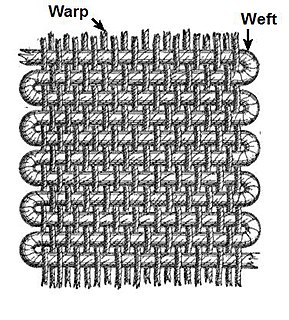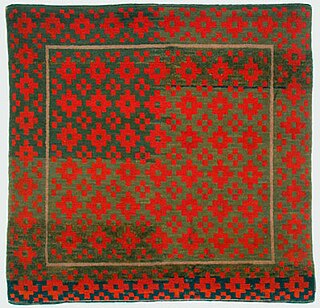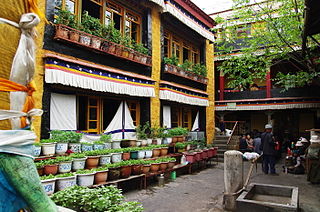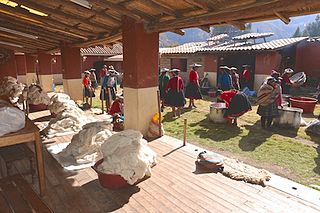Related Research Articles

Weaving is a method of textile production in which two distinct sets of yarns or threads are interlaced at right angles to form a fabric or cloth. Other methods are knitting, crocheting, felting, and braiding or plaiting. The longitudinal threads are called the warp and the lateral threads are the weft, woof, or filling. The method in which these threads are inter-woven affects the characteristics of the cloth. Cloth is usually woven on a loom, a device that holds the warp threads in place while filling threads are woven through them. A fabric band that meets this definition of cloth can also be made using other methods, including tablet weaving, back strap loom, or other techniques that can be done without looms.

Tibetan rug making is an ancient, traditional craft. Tibetan rugs are traditionally made from Tibetan highland sheep's wool, called changpel. Tibetans use rugs for many purposes ranging from flooring to wall hanging to horse saddles, though the most common use is as a seating carpet. A typical sleeping carpet measuring around 3 ft × 5 ft is called a khaden.

A Persian carpet or Persian rug, also known as Iranian carpet, is a heavy textile made for a wide variety of utilitarian and symbolic purposes and produced in Iran, for home use, local sale, and export. Carpet weaving is an essential part of Persian culture and Iranian art. Within the group of Oriental rugs produced by the countries of the "rug belt", the Persian carpet stands out by the variety and elaborateness of its manifold designs.

Shahtoosh is a fine type of wool made from the hair of the Tibetan antelope. It is also a metonym for a type of Kashmir shawl traditionally made of shahtoosh wool. The Shahtoosh shawl is now a banned item with possession and sale being illegal in most countries for the Chiru is an endangered species under CITES. However, the weaving of Shahtoosh shawls continues in secret in Kashmir due to high demand by western buyers. The estimated market value of one Shahtoosh shawl in the western market is around $5,000–$20,000. Shahtoosh is the world's finest wool having the lowest micron count, followed by vicuña.

Ethel Mary Partridge, Ethel Mary Mairet RDI, or Ethel Mary Coomaraswamy was a British hand loom weaver, significant in the development of the craft during the first half of the twentieth century.
An oriental rug is a heavy textile made for a wide variety of utilitarian and symbolic purposes and produced in "Oriental countries" for home use, local sale, and export.

Ani Tsankhung Nunnery is a nunnery of the Gelug school of Tibetan Buddhism in the city of Lhasa, Tibet Autonomous Region, China. It was built in the 15th century on a site that had been used for meditation by the 7th century Tibetan king Songtsen Gampo. The nuns support themselves through alms and manufacturing items such as clothing and printed texts.

Anatolian rug is a term of convenience, commonly used today to denote rugs and carpets woven in Anatolia and its adjacent regions. Geographically, its area of production can be compared to the territories which were historically dominated by the Ottoman Empire. It denotes a knotted, pile-woven floor or wall covering which is produced for home use, local sale, and export. Together with the flat-woven kilim, Anatolian rugs represent an essential part of the regional culture, which is officially understood as the Culture of Turkey today, and derives from the ethnic, religious and cultural pluralism of one of the most ancient centres of human civilisation.

Dechen Shak-Dagsay is a contemporary singer of traditional Tibetan Buddhist mantras in new modern melodies for younger generation. She is the daughter of the Dagsay Tulku. Born in Kathmandu, Nepal in 1959, Dechen and her family moved to Switzerland in 1963, where she has resided ever since.

Chief Nike Davies-Okundaye, also known as Nike Okundaye, Nike Twins Seven Seven and Nike Olaniyi, is a Nigerian batik and Adire textile designer.

Gunta Stölzl was a German textile artist who played a fundamental role in the development of the Bauhaus school's weaving workshop. As the Bauhaus' only female master she created enormous change within the weaving department as it transitioned from individual pictorial works to modern industrial designs. Her textile work is thought to typify the distinctive style of Bauhaus textiles. She joined the Bauhaus as a student in 1919, became a junior master in 1927. She was dismissed for political reasons in 1931, two years before the Bauhaus closed under pressure from the Nazis.

The textiles of Mexico have a long history. The making of fibers, cloth and other textile goods has existed in the country since at least 1400 BCE. Fibers used during the pre-Hispanic period included those from the yucca, palm and maguey plants as well as the use of cotton in the hot lowlands of the south. After the Spanish conquest of the Aztec Empire, the Spanish introduced new fibers such as silk and wool as well as the European foot treadle loom. Clothing styles also changed radically. Fabric was produced exclusively in workshops or in the home until the era of Porfirio Díaz, when the mechanization of weaving was introduced, mostly by the French. Today, fabric, clothes and other textiles are both made by craftsmen and in factories. Handcrafted goods include pre-Hispanic clothing such as huipils and sarapes, which are often embroidered. Clothing, rugs and more are made with natural and naturally dyed fibers. Most handcrafts are produced by indigenous people, whose communities are concentrated in the center and south of the country in states such as Mexico State, Oaxaca and Chiapas. The textile industry remains important to the economy of Mexico although it has suffered setback due to competition by cheaper goods produced in countries such as China, India and Vietnam.

Artisans Angkor is a Cambodian social business creating job opportunities for young people in rural areas, while reviving traditional Khmer craftsmanship.
Yak fiber is the term commonly used to refer yak fiber wool produced from the coat hair of yaks, a long-haired bovine mainly found in the Himalayan region, Tibetan plateau, and some areas of Mongolia and Central Asia.
DOBAG is the Turkish acronym for "Doğal Boya Araştırma ve Geliştirme Projesi". The project aims at reviving the traditional Turkish art and craft of carpet weaving. It provides inhabitants of a rural village in Anatolia – mostly female – with a regular source of income. The DOBAG initiative marks the return of the traditional rug production by using hand-spun wool dyed with natural colours, which was subsequently adopted in other rug-producing countries.

Centro de Textiles Tradicionales del Cusco was founded by indigenous weavers from the community of Chinchero as well as international supporters in 1996 as a non-profit organization. It is based out of the city of Cusco, Peru where its main offices, museum and shop are located. The CTTC works in support of indigenous weavers from the Cusco region to recover traditional Cusqueñan textiles. The organization currently partners with ten communities from the Cusco region: Accha Alta, Acopia, Chahuaytire, Chinchero, Huacatinco, Mahuaypampa, Patabamba, Pitumarca, Santa Cruz de Sallac, and Santo Tomas (Chumbivilcas).
Helen Lillias Mitchell MRDS MRHA was an Irish artist and teacher. She was the founder of The Irish Guild of Weavers, Spinners, and Dyers and the Weaving Department of National College of Art and Design.
Ritoma is a documentary film directed, edited and produced by Oscar-winning filmmaker Ruby Yang. It features Tibetan nomads who are passionate about basketball. This film mainly explores how Tibetans preserve their disappearing nomadic culture whilst cope with new challenges through basketball. Alongside with poverty issue and modernization.
Pearl Kinnear McGown was an American designer of hooked rugs and a teacher and innovator in the field who is credited with helping to bring the craft out of obscurity in the 20th century and gain it recognition as a form of folk art.

Mary Zicafoose is an American textile artist, weaver, and teacher who specializes in ikat, an ancient technique in which threads are wrapped, tied and resist-dyed before weaving. Zicafoose is the author of Ikat: The Essential Handbook to Weaving Resist-Dyed Cloth (2020). Her works are part of private and public collections, including at least 16 embassies around the world as part of the U.S. Art in Embassies Program.
References
- ↑ Pierce, Emma (2 March 2015). "Q&A with Kim Yeshi". Indagare Magazine.
- ↑ Lin, Qi (19 November 2013). "Yaks for haute couture". China Daily . Beijing, China. Archived from the original on 2 January 2015. Retrieved 2 February 2017.
- ↑ Wei, Annie (19 February 2013). "Norlha's shawls an exquisite investment". Beijing, China: Beijing Today . Retrieved 2 February 2017.